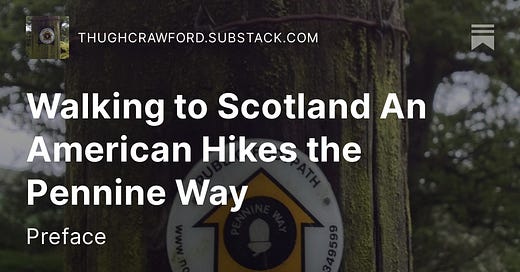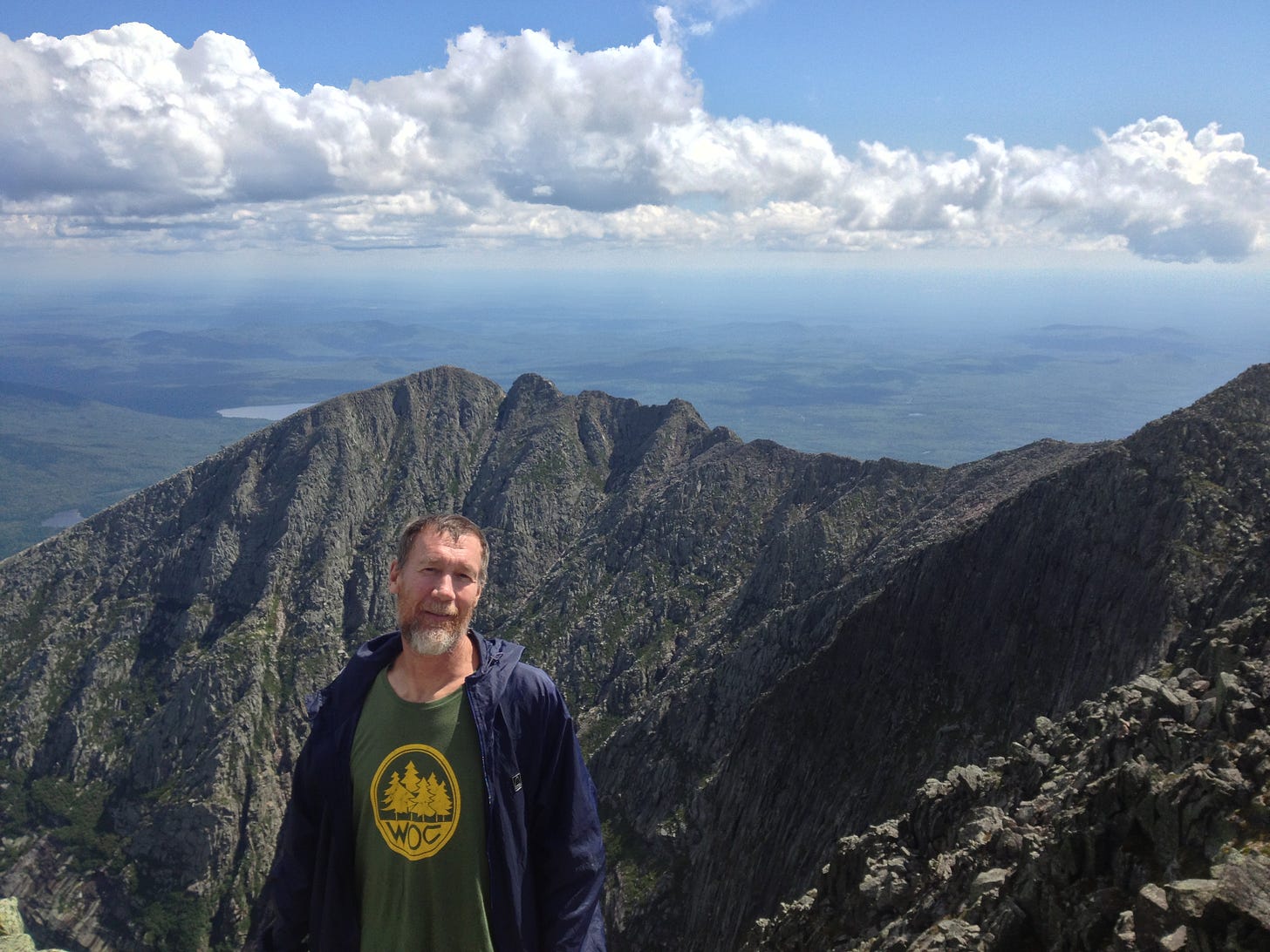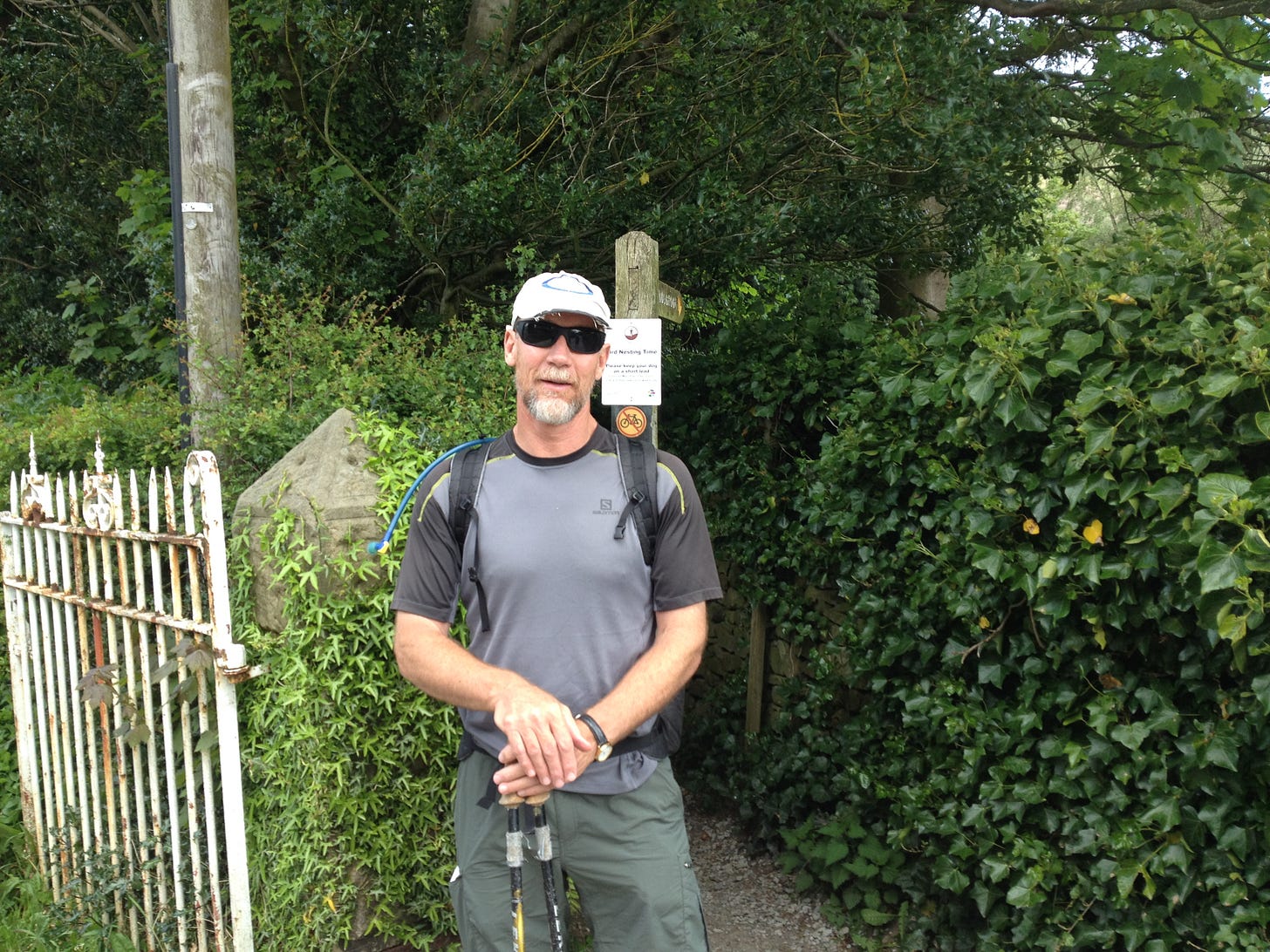Walk is an intransitive verb.
On August 12, 2013, my son Bennett and I climbed Mount Katahdin, the tallest mountain in Maine and the northern terminus of the Appalachian Trail. For the better part of three summers, we hiked, slogged, and stumbled, all the way--2185 miles--from Springer Mountain, Georgia. To be fair, I was the one doing most of the stumbling. Folks on the AT say that everyone has to hike their own hike, and we soon learned there are about as many ways to make that hike as there are hikers. We met retired soldiers, unemployed carpenters, would-be poets, homeless trampers, recent college graduates, and a wide assortment of just plain lunatics. You can safely claim that the Appalachian Trail is some kind of asylum, but common to most everyone's experience are the days spent at some distance from cities, towns, or even crossroads. We carried our food, water, and shelter, only re-supplying every four or five days, and then often at the only quick-mart anywhere near the trail. After gorging on ice cream, we would stock up on ramen noodles, Snickers bars, overpriced jerky, whatever was available that was light and relatively high in calories. That distance from civilization, along with the sheer physical rigor of the trail, brings an other-worldly quality to the experience. Hikers live in an alien world, one with different needs, demands, and values. Being on the AT is Being on the AT.
As that last summer wore on, we anticipated, almost daily, summiting Katadhin. It became a mountain shimmering in some mythic land, one we hoped one day to gain admittance. Katadhin does shimmer, both as an idea and as a granite massif which looms up in the distance, sometimes glimpsed as far away as the Bigelow range and daily becoming more and more real, more and more material. At the same time, the space between becomes more and more difficult, the run-up to Katahdn is the "100 Mile Wilderness," a place more dreadful in anticipation than in actuality. While not a trivial effort, the 100 mile wilderness is hardly the impossible test that it often is portayed. There is limited access, and much swamp trekking, but, compared to the foreboding it calls up, it is a walk in the park. Because Bennett and I needed to time our arrival at Katadhin's base on August 11, we found ourselves dallying over our time in New Hampshire and western Maine. There I developed an inordinate fondness for decrepit motels in destitute towns. Sitting on a folding lawn chair on the sidewalk in front of a motel room with a book and a cold beer became synonymous with the good life. But Katadhin beckoned -- a mountain more often than not covered in mist. Henry David Thoreau called it a "cloud-machine", an apt description and the source of much disappointment for hikers whose triumphant moment--the climbing the pinnacle sign to pose for the photo with trekking poles held triumphantly aloft--often happens in the thickest of mist. They can only imagine what spreads out before them in the Maine valleys to the south and the east, the direction of home.
That day in August, joined by Tom, another son, we climbed in a clarity rarely experienced. The light was prismatic, the shadows sharp, the rock both black and warmly aglow. We strolled, we sauntered, we knew that after months of pure exhaustion, this day was to be our last. It was sad, it was triumphant, and was still painful. I was nursing yet again another infected toe, that throb an almost constant companion for thousands of miles. On reaching the top, Bennett drew from his pack a watermelon and three almost-cold beers, and we feasted in the warm glow of accomplishment. Then we turned and walked back into the regular world, both vowing with each step to find a way to keep what we had learned close, not to fall back into the quotidian, to continue in some small but significant way to hike the trail.
In her masterful but largely unknown book, The Living Mountain, Nan Shepherd explores a different massif, the Scottish Cairngorms. She expresses this same feeling: the compulsion of walking and the hope of keeping what it gives close: "One walks among elementals, and elementals are not governable. They are also awakened in oneself by the contact elementals that are as unpredictable as wind or snow." When asked about my experience hiking the AT, I often use that term--long distance hiking is elemental. It brings you close to the earth and the sky, close to yourself, and yet remains unpredictable. It is, as Shepherd says, ungovernable. That intensity of focus, the care it demands, gets into your blood. While many people who finish the AT throw up their hands and say, that's that, many others are already plotting their next trek. In shelters at night on the trail, hikers talk wistfully of the Pacific Crest or the Santiago de Compostela. And we sometimes met people who rarely left the trail, those who wintered briefly in Florida, saving enough money to start back at Springer in early March, yo-yoing up and down until winter drives them off again. For them, the long-distance hiking is a way of life.
I have to confess, I'm not among that number. I found the trail elemental, but also brutal, a test of will and endurance. On passing that test, I decided there was no need for another such measure. Still, like Nan Shepherd or even our own Henry David Thoreau, I continued to feel the overwhelming urge to get outside. Rooms made me claustrophobic, and standing made me want to walk. I found myself always wearing hiking shoes, at times inappropriately, so the following summer I was off to Europe, first to backpack for a short time in Croatia and then somewhere in the United Kingdom. Eventually I would be teaching in an Oxford summer program, but first I needed to find something to do for a month, something not too expensive, something outside, something that included walking. I had a simple criteria: no matter the distance, there needed to be a pint of ale at the end of each day, a shower, a warm meal, and a soft(ish) bed. Don't get me wrong, I do remember fondly camping on the AT, eating dehydrated camp meals, peanut butter, and lots of Ritz crackers, sleeping on a thin pad on the wooden floor of a rat-infested shelter. I just thought it would be nice to try something different and the UK, with its many long distance trails seemed the answer.
What settled it, though, was stumbling quite by accident on a short book by the English poet Simon Armitage called Walking Home. I confess, I found it not because I was looking for a trail. Rather, I was plotting out a book on my experience hiking the Appalachian trail, and I wanted to call it "Walking Home." Armitage beat me to the punch, so, at the very least I needed to read his version. What I found was a book that followed a pattern similar to other long distance hiking books such as Bill Bryson's Walk in the Woods, or Cheryl Strayed's Wild: a novice hiker sets out to explore the world of long distance hiking, works through tenderfoot status, meets adversity and a variety of unusual people, then gains skill and confidence only to fail in the original quest-- completing the trail--but to succeed in whatever personal quest they had. Armitage's spin was that he took on a much more manageable trek for a novice---the 265 mile Pennine Way rather than the 2000+ AT, and his failure to complete was more an aesthetic gesture than his inability to overcome physical limitations or an unforgiving nature.
In 2010, Armitage the poet decided to follow in the footsteps of the troubadours -- well, not exactly. He wasn't wandering the Provençal region like the singer/storytellers of yore. He decided to hike the Pennine Way, a long-distance path often called the English Appalachian Trail that runs from a point near Manchester to just across the Scottish border in a hamlet called Kirk Yetholm. With a certain jocular perversity, he decided to hike south, against the thin stream of Pennine hikers almost all of whom, just like their AT and PCT counterparts, hike north. Northbound (NOBO) is a compelling direction for AT through-hikers (those who complete within one calendar year) because, to steal a phrase from Earl Shaffer who was the first successful AT through-hiker, you hike “north with the spring.” Most through-hikers leave Springer in March or April to be sure they can summit Katahdin before October when the weather can close off access. As a result, the trail is populated by waves of hikers-- those who push hard and long, summiting in early August, followed by those who hike a more civilized pace, finishing some time later in the fall. (I once met a hiker in April heading south on the access trail to Springer, only to discover he was a south bounder (SOBO) having left Katahdin almost a year earlier. He was completing that day, having hiked all through the winter). Pennine Way hikers don't concern themselves with too much the seasons. The primary reason for hiking north is the weather-- the prevailing winds are usually from the south, and no one wants to be facing the wind up on a fell in wet weather if it can be avoided.
Armitage's book chronicles his poetic troubadourship, sauntering from town to town along the Way, staying with friends and admirers, giving poetry readings, passing (what I hope was a clean) sock to collect contributions, then setting out the next day for yet another town. I thought, that's for me--not the reading poetry to an audience, or staying with friends (afraid I didn't know anyone living along the way). Some people hike the Way in a week or so, but most take 18-20 days. The idea of a leisurely three-week saunter through the Yorkshire downs, sleeping in feather beds, savoring the best Yorkshire cuisine and real ales, was more than appealing. Decision made: no tent, sleeping bag, jet-boil stove or 48 liter backpack, just an ultralight small pack with some clothes, rain gear, ipad and a tuna-mayo sandwich packed for lunch. Of course I had no idea what I was getting into. The Pennine Way is much different from the Appalachian Trail, but it is no walk in the park. This is my walk in that magical place.





